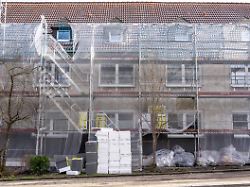Experts express doubts
Can the building climate plan 2045 be implemented?
05/28/2023 09:34 am
Experts agree that the 2045 building climate plan issued by the federal government can only succeed under certain circumstances. However, it is questionable whether the immensely increased need for personnel and capital can also be covered.
According to experts, a six-digit number of new skilled workers and additional capital in the three-digit billions to trillions would be necessary for the goal set by the federal government of climate-neutral buildings by 2045. The Central Association of the German Construction Industry (ZDB) assumes that the industry would have to hire 150,000 to 200,000 additional workers. That said ZDB general manager Felix Pakleppa of the German press agency.
The Federal Ministry of Economics also had the personnel requirements determined. The report published in March mentions 215,000 additional jobs that could be created for energy modernization in the building trade. “This is the only way to achieve the necessary increase in the renovation rate,” says the “Building Strategy Climate Neutrality 2045 Background Paper”.
The Prognos Institute was in charge, and the Freiburg Öko-Institut and the federal German Energy Agency were also involved. The increased need for personnel results from the fact that the current “renovation rate” of approximately one percent of the housing stock per year would have to almost double, according to calculations by various experts, to 1.8 or 1.9 percent per year.
It is unclear where and how a six-digit number of new craftsmen and construction workers are to be recruited. “Currently, we’re only achieving a refurbishment rate of one percent per year,” says Axel Gedaschko, President of the Federal Association of German Housing and Real Estate Companies (GdW). “And there is already a massive shortage of materials and skilled workers.”
The recovery rate would double
According to the Federal Statistical Office, there are a total of over 43 million apartments in Germany. The commonly estimated refurbishment rate of one percent would therefore correspond to over 430,000 modernized apartments per year. For an approximate doubling, an almost as high number of apartments would have to be additionally renovated every year.
However, there is no sign of a large wave of recruitment in the building trade. Instead, the current slump in housing construction is causing trouble for the industry. “We can clearly see that the construction industry will cut jobs on balance in Bavaria,” says Manfred Gößl, the general manager of the Bavarian Chamber of Industry and Commerce. “There are no signs that we are getting a boost from external conditions.” Gößl refers to the Free State, but the construction industry is no better off elsewhere.
An immediate doubling (of the renovation rate) is “simply not feasible,” says GdW President Gedaschko. “Resolving something doesn’t mean that it works in practice.”
Significantly higher costs
As for the additional capital required, the calculations differ, but in any case the amounts involved are staggering. The background paper by the Federal Ministry of Economics mentions additional investments of 448 billion euros by 2045.
The Kiel-based working group for contemporary building came up with a much higher sum last year. “However, the costs make you a bit dizzy,” says ZDB general manager Pakleppa. So far, homeowners and housing companies have spent around 50 billion a year on energy modernization.
Based on the EH 115 standard – the previous old building standard – according to Arge Kiel, 110 billion euros per year would be necessary, says Pakleppa. “If you want to go to the EH 55 standard required by the Federal Ministry of Economics, we need 165 billion a year. That means by 2045 that would be 3.4 or 3.5 trillion, I want to be generous with the comma.”
Pakleppa emphasizes that he still considers the goal of climate neutrality to be achievable by 2045 – provided that the framework conditions, including state subsidies, are right.
Reviewer: It is by no means optimal
The experts commissioned by the Federal Ministry of Economics also assume that a climate-neutral building stock is feasible by 2045, but the “solution corridor” is “very narrow”. If everything doesn’t go smoothly, the plan will fail: “Deviations in individual fields of action can hardly be compensated for and lead to the target being missed in 2045,” says the paper. However, almost all experts agree that things are by no means optimal at the moment and that, apart from the lack of skilled workers, significantly higher state subsidies would be necessary.
“Just to meet the requirements of the Building Energy Act, an amount of around 61 billion euros would have to be invested in the housing companies organized in the GdW over the next 20 years,” says its President Gedaschko. “The draft law currently only provides for support for owners. It has so far been completely open how tenants and landlords are to be supported.” The companies did not have the equity and liquidity to provide significant new construction, refurbishment and heating replacement. “This is a completely unacceptable situation for a country where almost 60 percent of households rent,” says Gedaschko.
The GdW is not an association of real estate sharks, but the umbrella organization of housing cooperatives, municipal companies and other socially oriented landlords. The experts at the Darmstadt Institute for Housing and the Environment (IWU) also consider significantly higher state subsidies than previously to be sensible or necessary.
“In new construction, the primary focus should be on legal regulations,” says IWU expert Andreas Enseling. “Funding can be used to accompany this. In the portfolio, we believe that a combination of significantly increased funding and expansion of CO2 pricing would be best suited to achieve the goals of climate neutrality.”
